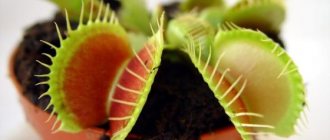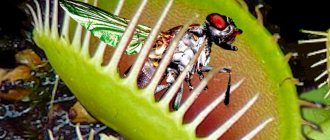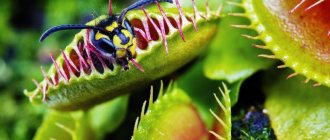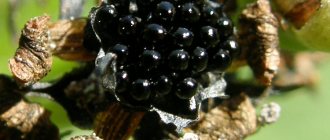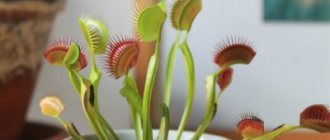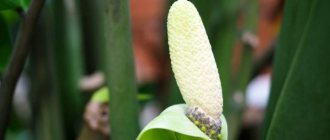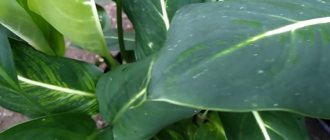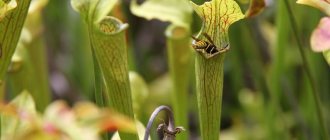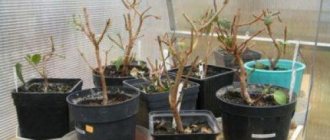Carnivorous plants! Strange name, isn't it? There are insectivorous birds, there are insectivorous animals - this is understandable. But is it possible to imagine a plant eating insects? Meanwhile, such representatives of the plant world exist, and there are even quite a lot of them: about five hundred different species. Protein food is also necessary for these plants, as it is for carnivorous animals.
The English naturalist Charles Darwin was the first to study in detail the life of insectivorous plants: in his works he showed how predator plants are structured, how they manage to catch their prey, how they digest protein foods, and also explained why these plants became carnivorous.
Pemphigus
Plants, which are given one common name - bladderworts, feed on the rotted remains of insects and other animals.
Bladderwort (Utricularia) is a large genus of insectivorous plants in the bladderwort family (Lentibulariaceae). Four species of the genus can be found almost throughout the entire territory of Russia, except for the regions of the Far North.
Bladderworts live in bodies of water - puddles, swamps and rivers. Their thin branching stems float on the water and, by the time of flowering, shoot out erect shoots, on the tops of which flowers bloom. The plant has no roots at all and is not attached to the bottom by anything.
The “hunting” of this plant is passive. Among the thread-like leaves of the bladderwort are many small pale green vesicles the size of a pea. Each bubble is a trap for small swimming creatures. The trap is intricately designed. At one end of the bubble there is a thin stalk (petiole) - with its help the bubble is held on the stem. At the other end there is a small opening, like a mouth, surrounded by hard, bristly hairs. The hole is covered with a valve, which swings back freely at the slightest external pressure, and then lowers again and locks the passage inside the bubble.
The bladderwort plant has chosen those places where there are a lot of small animals (mosquito larvae, various water worms, tiny crustaceans, fish that have just hatched from eggs).
All these small fry love to scurry among the stems of bladderwrack, not knowing for the time being that trouble is very close. Now the water flea pushed into the “door” of the bladderwort, and then the valve lifted and let the dear guest inside. Following this, the plant immediately closes the entrance to the trap, and the prey is caught. There is no way back for the insect: after all, the valve opens from the outside to the inside of the bubble, but it does not open from the inside to the outside. The prey dies and rots inside the traps, and its decomposed remains seep through the walls of the bubbles into the body of the bladderwort.
Sarracenia
In the swamps of North America there grows a plant that scientists have dubbed the name “sarracenia”.
Sarracenia is a genus of plants in the Sarracenia family. Today there are 10 species, as well as several subspecies and about 100 varieties created by breeders.
This plant has very interesting leaves; With their help, Sarracenia hunts.
Each leaf looks like a bag or jug, narrowed at the top and bottom and swollen in the middle. At the hole that leads into the jug, protrudes a green leaf blade with burgundy-colored veins, reminiscent of a shell. It collects raindrops. From this vessel, rainwater penetrates into the bag and fills it approximately 1/2. There is always at least a little water in the bag, even in drought. Sarracenia leaves serve as trapping pits (or trapping pitchers) for insects - both winged and wingless.
Almost all types of sarracenia have brightly colored leaves. From a distance it’s like flowers—beautiful and elegant. Insects are captivated by this beauty, and this is so beneficial for the plant. The lower half of the leaf is bright green. At the bell it is light green and covered with a network of red veins. The dome looks especially colorful; here the leaf wall is very thin, almost transparent and completely decorated with veins. Well, how can you not covet such beauty?
Noticing sarracenia leaves from afar, insects approach them in the hope of eating something tasty. Their hopes are not in vain - the leaves have an excellent bait: inside the trapping jugs, at the very entrance, there are nectar-bearing glands. Looking into the middle of the leaf, the insect sinks deeper and deeper until it drowns in the liquid filling the jug. The drowned man rots, decomposes, and its rotten remains are absorbed by the walls of the sarracenia leaf. In its trapping pitchers you can find many small insects, and sometimes even frogs and rodents.
This exotic plant is also suitable for home keeping. In summer, it can be taken out to the balcony, where it will independently obtain food for itself, and in winter, it can be given food for fish.
Nepenthes
The plants that were considered (sarracenia, bladderwort) feed on the corpses of small animals, i.e. they eat, so to speak, carrion. They do not produce their own “stomach juice”, unlike plants, which we will talk about later.
So, it’s like a ladle in front of you, but it’s also a leaf. Its petiole is swollen at the end in the shape of a ladle, its edges are densely lined with sharp teeth, which face the inside of the ladle, and above them is a lid (leaf plate). The plant on which such strange leaves hang is called “nepenthes” (or pitcher plant).
Nepenthes is a genus of carnivorous plants of the monotypic family Nepenthaceae.
In total, 7 species of Nepenthes are known in the world. They come from hot countries.
Nepenthes do not grow very well in greenhouses and rarely produce large leaves. But in natural conditions, in their native lands, they form simply huge leaves. For example, on the island of Borneo, in the forest, there are Nepenthes with pitchers more than 45 cm long, and the hole leading into such a huge leaf is 13 cm or more in diameter. They say that a pigeon that wanted to fly into such a pitcher could freely I would like to hide in it.
As you probably already guessed, the pitcher leaf of Nepenthes is a trap for all kinds of insects, both large and small, both winged and wingless. If you look into one of the jugs, at the bottom you can find a whole bunch of insects, dead and still alive.
As we have already said, in the tubular leaves of sarracenia and in the vesicles of the bladderwort, insects rot, decompose, and the liquid obtained from their corpses gradually passes into the body of the sarracenia and bladderwort. For Nepenthes, everything is different: once the insect gets into the plant’s jar, it is digested. At the bottom of each Nepenthes jug there is a special sour liquid. It then digests the insects that have climbed into the jug in much the same way as the gastric juice secreted by the walls of our stomach digests pieces of meat.
As you know, there are many birds that feed on insects. Having learned that rich prey can be found in the pitcher leaves, insectivorous birds climb inside the pitchers and drag insects from there.
Is it possible to put your fingers into the “mouth” of a Venus flytrap?
It's possible, but not necessary. Nothing will happen to your finger; a bite from a Venus flytrap will not harm you. BUT, the Venus flytrap itself spends a lot of energy on triggering the trap and after triggering the trap dies. If you stick your fingers into the plant, it will quickly die.
Overwintering a Venus flytrap in an apartment
The Venus flytrap requires a cold winter. There are tips for preserving the plant in the refrigerator, but it is difficult. It’s easier to store on an insulated loggia. Watering at this time is reduced to a minimum. The dormant period lasts 4 months, from November to February.
Rosolist
Roseleaf (Drosophyllum lusitanicum) is a very interesting small plant that grows in sandy or even rocky soils in Portugal and Morocco. Its long leaves - like braid - are crowded at the base of the stem, at the top of which several large flowers usually bloom. The whole plant seems to be covered with drops of dew. Hence its name. In fact, this is not dew at all, but small droplets of sticky thick mucus, which serve to catch insects.
As soon as some mosquito, ant or bug lands on a dew leaf, the insect’s entire body immediately becomes covered with drops of sticky liquid - and then it can no longer escape. Then another juice secreted by the leaves comes to the aid of the glue. It digests all the soft parts of the insect’s body.
Sundew
The dew leaf plant should not be confused with another plant that grows in Russia, in swamps, and also here and there along the banks of streams. It's called sundew.
Sundew (Drosera) is a small plant with leaves that are clustered at the base of the flower stalk, similar to those of the dew leaf. However, unlike the latter, its leaves look more like spatulas.
Looking at a sundew, the first thing you notice is that each leaf is lined with long pink hairs (eyelashes) on top and on the edges. The tips of the eyelashes are thickened and covered with drops of shiny juice. Small insects mistake this juice for honey and willingly land on the leaves of the predator plant in the hope of feasting on the honey.
A fly flew in and carefully landed on the leaf, but caution did not help: it touched the hairs with its paws and smeared itself with sticky juice. The fly tries to correct the mistake and sneak away, but that was not the case. The more it rushes about on the surface of the leaf, the more often it touches the hairs, the more juice they secrete. With every movement of the fly, retreat becomes more and more difficult. Finally, exhausted by fruitless attempts to escape, completely smeared with sticky juice, as if tied hand and foot, she resigns herself to her bitter fate and no longer fights. And then the sundew’s hairs begin to bend over the victim’s body one after another, attach their heads to it and pour juice over it. This is their purpose, that’s why they stick out on the leaves of the predator. The juice digests all the soft parts of the fly, and when, a few hours later, the eyelashes rise again, there is practically nothing left of the fly.
So, the sensitive hairs of the sundew are able to move when necessary.
Plants-predators of Russian nature
Insectivorous plant sundew rotundifolia
All carnivorous plants, just like ordinary ones, have roots, stems, leaves and flowers, but there are also characteristic differences that allow them to lead the lifestyle of a predator. For example, each sundew leaf is covered with small red hairs. In turn, at the end of each hair a head is formed that secretes a very viscous liquid resembling dew (hence the name of the plant - sundew). Insects mistake the liquid for nectar, sit on it and immediately stick tightly to the hair. Trying to escape, the sundew's victim hits neighboring destructive traps and finally finds itself captive of the predator plant. After capturing the insect, the sundew leaf begins to fold and forms a deadly sac around the victim. The hairs inside the sac secrete digestive juice, the prey is digested and absorbed by the plant body. The process of digestion and absorption takes several days.
Predator plant butterwort
Zhiryanka grows in the swamps of northern Russia. Its leaves form a rosette and are shiny with a sticky fat-like lubricant. The lubricant is secreted by trap glands located on the surface of the leaf, next to which are adjacent other digestive glands. The zhiryak hunts crawling insects. Attracted to the surface of the leaf by a fat-like lubricant, they firmly stick to it, and then, like the sundew, the butterfly leaf folds into a bag, the corresponding glands secrete juice with digestive enzymes, and after a day the prey insect is completely digested by the predator plant.
Plant predator of bladderwort
Pemphigus has no roots, constantly swims and preys on small crustacean aquatic animals - daphnia and cyclops. The plant was named bladderwort because it catches and digests prey with the help of small trapping bubbles located on its surface. Pemphigus trap bubbles have a semicircular valve that opens inward, and the pressure in them is lower than the pressure of the surrounding aquatic environment. When the victim touches the sensitive hair located on the valve, it opens with lightning speed, the prey is drawn into the bubble by a stream of water and is digested there. Bladderwort is the fastest and most surprisingly voracious plant predator. Sometimes she eats up to 300 small aquatic animals per day.
flycatcher
The leaves of another insectivorous plant also have the ability to move. We will talk about the famous Venus flytrap or Dionaea muscipula.
Its leaves with thorns, capable of folding in half, are real insect traps. As soon as any insect sits on a leaf, its halves immediately slam shut and open again only when all the soft parts of the caught prey are digested and absorbed by the leaf. The flycatcher grows in the swamps of North America.
Growing a Venus flytrap
In nature, the Venus flytrap grows on swampy peat soils, poor in nitrogen; it is the lack of nitrogen that causes the traps to appear: insects thus serve as a source of nitrogen, which is necessary for the synthesis of proteins and is insufficient in the environment.
Venus flytrap killer plant requirements when grown indoors
The Venus flytrap, or Dionaea, can be grown as an indoor crop, but the normal development of the plant in this case is difficult due to the very high air humidity it requires and the low temperature in winter.
Lighting
Bright but not sunny location. An east-facing window sill would be suitable.
Soil for Venus flytrap
The Venus flytrap is VERY picky about the soil; any change in acidity or drying out of the soil can lead to the death of the plant. So, only high-moor peat is suitable for the Venus flytrap.
Venus flytrap pot
Any small pot is better with thick walls to prevent drying out. Place a large tray under the pot, into which you constantly add water. This way you will provide her with native swampy conditions in an ordinary room.
The Venus flytrap can be grown in florariums, where it is easy to create suitable conditions.
Watering a Venus flytrap
You need clean, ideally distilled water. This can be found in 3-5 liter bottles in auto stores.
Feeding the Venus flytrap
Mineral fertilizers are not needed.
What about live food? Should I feed my Venus flytrap insects?
One fly per month is enough for one plant. But sometimes she can eat more. The most important thing is that the insect must be ALIVE!
Why did plants become predators?
Surprisingly, it is a fact that not only predatory animals live on our planet, but also predatory plants. Why did they become like this?
Remember on what soil these representatives of the plant world live. Some are in swamps, others are among stones or sand. How many nutrients can a plant get from swampy or sandy soil with the help of its roots? Of course no. And so, forced to live in such harsh conditions, plants learned to catch insects and eat their meat. As we see, under the pressure of need, a special breed of carnivores appears, i.e. meat-eating plants. At the same time, some of them feed on carrion, while others lure live prey and digest it with the help of juices, greedily absorbing the digested food. These latter, such as Nepenthes, sundew and flycatcher, can, if necessary, eat pieces of meat and hard-boiled eggs.
If you put a piece of egg or beef on a flytrap leaf, the halves of the leaf will immediately slam shut, then a liquid will begin to be released from the leaf, which will digest both the meat and the egg. When the food is digested, the leaf will absorb it.
However, it is worth noting that when growing a flycatcher at home, you should not experiment and feed it with meat, eggs and other human food - this can destroy it. Usually, in an apartment, she is able to get her own food. But if flies and mosquitoes do not come to you, then you will have to feed her - 2 times a month, offer her live insects - flies, spiders, slugs.
Why did carnivorous plants become predators?
The explanation for this natural phenomenon is very simple. Plants growing in swamps lack the minerals necessary for existence that plants growing on the terra firma obtain from the soil (for example, nitrogen and phosphorus). And they found the only way out of this situation - they learned to eat insects. On the other hand, in order to absorb the nutrients contained in the eaten insect, the predator plant needs a lot of water and therefore this method of replenishing its diet could only have arisen among the inhabitants of swamps. Among, for example, desert plants existing in the same unattractive conditions for life, there are no predators.
